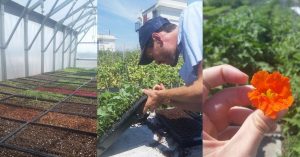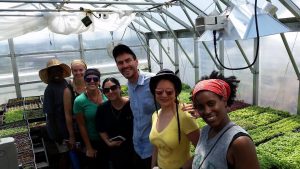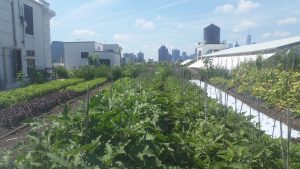Last week, I had the opportunity to attend the Sustainable Farming Program with Chef Jay Weinstein and the Natural Gourmet Institute. The certification program included lectures, hands-on work, preparing and sharing meals together, a lot of sweat, and a lot of smiles.
5 days, 2 states, 3 farms, 1 farmers market, and 1 greenmarket distribution hub.
Day 1 and 2: The Brooklyn Grange Farm
Our first two days were spent with a great group of individuals on a rooftop farm in the Brooklyn Navy Yard. The Brooklyn Grange has two rooftop farms in New York, one in the Brooklyn Navy Yard and one in Long Island City, Queens. Together, the two farms produce around 50,000 pounds of produce annually.
Before we get into the rooftop farm, let’s talk a little about urban agriculture.
Urban Agriculture: What is it?
Urban agriculture is defined by the Five Borough Farm as the integration of: producing fruits, vegetables, herbs and animals, processing and distributing that food, all while creating as least waste as possible (reusing resources). Combine all of that with the responsibility of educating the local community on the production of food and where it comes from, as well as employing some of the community, and there you have it: urban agriculture.
Benefits and Challenges:
With all good things comes [some] bad. When we first arrived at the Brooklyn Grange, we were lucky enough to have a short lesson from Anastasia Cole Plakias, the Vice President and Founding Partner of the farm, on the benefits and challenges faced in urban agriculture.
Benefits:
There are a plethora of benefits that come along with urban agriculture. A few ecological benefits include: composting, which reduces the amount of waste being produced, reducing combined sewage overflow (CSO), and the green space reducing the severity of Urban Heat Island Effect.
Urban Heat Island Effect: the absorption of heat through city roofs and building (from the sun).
Other benefits that go hand in hand with urban agriculture are economic and community benefits, a few of which include: potential employment, educational opportunities, reduction of noise pollution, green space access, and increased access to fresh, seasonal produce.
Challenges:
Along with a long list of benefits, can come a list of challenges as well. A few physical and fiscal challenges urban agriculture often faces are: soil and air quality (can be a problem in urban communities), flooding, water quality and availability, value of real estate, and the costs of labor in a high-cost living community.
Rooftop Farming: How does it work?
After learning all there was to learn about urban agriculture, (kidding, there is still SO much to learn), we had the awesome opportunity of getting hands on experience, and tasting everything from lime basil to ground cherries and kale with President and Director of Agriculture, Ben Flanner.
Flanner gave us a first hand look at how the Brooklyn Grange runs and the amount of work that goes into maintaining a rooftop farm.

Far Left: A look inside the greenhouse, Center: a lesson on greenhouse microgreens from Ben Flanner, Far Right: an edible flower.
Rotating Crops:
Like we said before, the Brooklyn Grange Farms collectively produce around 50,000 pounds of produce and herbs per year. Unlike some conventional farms, the Brooklyn Grange focuses on the rotation of crops after harvesting, rather than adhering to monocropping, in order for their farm to healthfully produce thousands of pounds of produce each year.
Monocropping: is the practice of planting the same crop year after year on the same soil. Monocropping is problematic due to the fact that, planting the same crop over and over again strips the soil of the nutrients it needs to grow a plant. Conventional farms are often required to use chemical fertilizers in order to make up for that lack of nutrients, and to be able to produce those same plants year after year.
They’re not using chemical fertilizers, but are they using chemical sprays? (pesticides, herbicides, etc.?)
Nope!

Insects and Soil:
The Brooklyn Grange uses zero chemical or synthetic fertilizers, pesticides or herbicides. Instead, the soil used includes organic nutrients mixed with mushroom composts and porous stones. This ensures suitable drainage and an addition of minerals needed by the plants.
To be sure their soil and plants are in the best shape as possible, the Brooklyn Grange also uses nitrogen fixing crops that organically add nutrients back into the soil and prevent soil erosion.
Soil Erosion: is a naturally occurring process that takes place due to wind, water and/or tillage.
Water:
While you might think rooftop agriculture relies on rainwater to hydrate the plants and soil, that’s not always the case. The Brooklyn Grange is rigged with an irrigation system that, when needed, is used to water the plants.
But what if it rains too much?
Remember that soil we discussed earlier? The porous stones included in the soil ensure a drainage process that takes place in order to not “drown” the plants.
And that’s it! Not really. There are so many factors that come into play when working with urban agriculture and rooftop farming. But those are three of the main takeaways we learned about the process of rooftop farming.
Now that you understand a little bit about how rooftop farming works, who’s ready to hear me identify 10 different types of weeds! Any takers? No?
A huge thank you goes out to the whole crew at the Brooklyn Grange Farm, as well as the Natural Gourmet Institute and Chef Jay for a humbling and knowledgable experience at the farm.

File Credit: Jay Weinstein
Stay tuned next week to learn more about different types of sustainable farming practices!
 Food
Food Farmers
Farmers Sustainable Living
Sustainable Living Living Planet
Living Planet News
News


